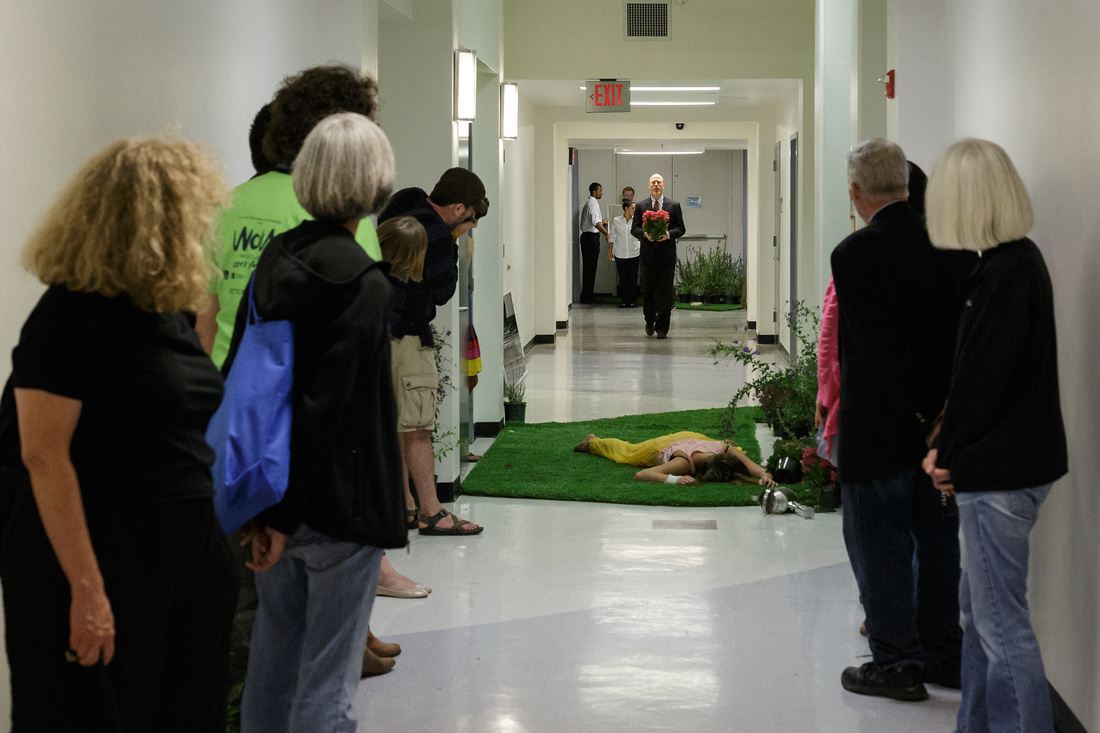Before I started devising, I thought it was a concept that sounded awesome, but I didn’t know how I could fit into that world. I thought devising intrinsically meant there was no room for a playwright. It turns out I was totally wrong. And I’m so glad I was.
Before I go any further, let me explain what I mean when I say devising. It’s a word we use in theater to cover a multitude of sins. I’m using it to talk about work that’s generated in a nontraditional way, i.e. work that’s made outside of the model where a playwright writes a play, and hands it off to a theater/director, who hires actors, etc.
In some obvious ways, devising is much more challenging than the traditional model. As playwrights, we can sit down and write anytime we want. All we need is discipline (or maybe a little deadline pressure). But I love devising because I can share the burden of solving dramaturgical problems with my collaborators. And inherently, I create work that I couldn’t possibly have imagined on my own.
So how does a playwright become a deviser? It’s a snap with these seven simple steps.
Step 1. Find your collaborators.
Usually in the bar.
But seriously, almost all of my devised collaborations (with one notable exception) have begun as personal relationships. We’ve discovered over time each other’s interest in devising and decided to give it a try. What’s been key in these relationships is mutual respect. I really admire the artists that I devise with on their home turf, so to speak. This is so important, because in a minute, everything is going to get catawampus. (See Step 3 below.)
Step 2. Throw out your assumptions.
In devising, the process is inextricable from the product – this is arguably true in any work of art, but this takes on additional weight in a form of collaboration in which the process is totally up for grabs. Throw out all the assumptions you have about your role as the playwright, the way you’re going to work with your collaborators, and what you’re going to end up with. Instead, ask each other questions about all of these things. What will each of your roles be? How do you want to work? How much input will your collaborators have in the writing? How much input will you have in other areas? What are your goals? Do you have everyone you need to create your piece, or do you need to recruit more artists? Do you need to reach consensus, or will you make decisions another way? Now is also a great time to research amazing devisers like Pig Iron, Rude Mechs, Joint Stock Company, The TEAM, and Stein|Holum Projects.
Step 3. Go catawampus.
Get on your feet and start making! Don’t spend too long talking before you get to work. It’s easy to talk things to death. But you won’t actually know what your process is until you’re inside of it. It’s okay for things to change as they go along. They will anyway. The important part during this step is to keep the lines of communication open with your collaborators. For me, it’s important to get on my feet during this part of the process – even if it’s just for warm ups at the beginning of the day. Staying at the table and observing the whole time keeps me too removed from my collaborators.
Step 4. Take your time.
Devising takes time. Lots of it. Estimate how much time you think it’s going to take you to do this work. Now quadruple it. That’s how much time it’s going to take you to get started.
Step 5. Keep going!
Generate lots of material. Make sure to document what you’re doing, so you can reference that really cool thing you did that one Tuesday right before you called it a night and went to the bar. Don’t be precious. Make digressions. Discover that the digression is actually the heart of the piece. Throw everything else out. Generate more.
Step 6. Move towards production.
Once your piece has started to cohere, you move into a more traditional rehearsal format. (This might not always be true, but it’s always happened for me.) Maybe now you even – finally, here in Step 6 – have a script. This is a good time to check back in with your collaborators about your expectations and your roles now that your process is evolving. Many devising companies also share their work at multiple points in the process – sometimes with audience members, sometimes just with trusted friends. I’ve found this to be invaluable. Whoever you invite, ask them questions. Really listen. Be ready to make big changes. You might even discover that you want to throw out whatever you have of a script and go back a step, or a few steps. Keep an open mind, and an open heart. This is why you have collaborators! You’re in it together.
Step 7. Production.
Congratulations! Now go back to Step 1.
All of this is, of course, the barest of outlines, and doesn’t account for the million (mostly exciting, a few heartbreaking, and all terrifying) vicissitudes in the process. Every time I undertake a new devising process, I re-learn these steps all over again. And every time, it’s a joyful journey of self-discovery as well as an artistic practice.

Above: The audience watches Ophelia’s funeral procession in A Willow Grows Aslant, an immersive retelling of Hamlet created by playwright Kristin Idaszak, production designer Natalie Khuen, and director Kate Jopson. A Willow Grows Aslant premiered at La Jolla Playhouse’s 2013 WoW Festival. Photo by Jim Carmody

Above: In Commence, conceived by Erin Tracy and created by playwright Kristin Idaszak, choreographer Erin Tracy, and composer Ryan Welsh, the three devisers explored different ways of beginning - through music, language, and dance. In this photo, Tracy enacts the story of David and Goliath. Commence was created for the Patricia Rincon Dance Collective’s Salon Dances series in 2015. Photo by Jim Carmody

 Facebook
Facebook Twitter
Twitter